|
This article on Sunvention's Solar Power Villages is also available as a PDF article
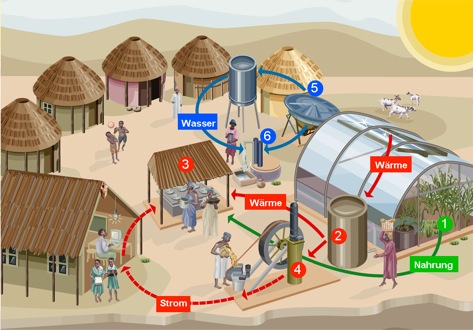 Autonomous power for villages Autonomous power for villages
Sunvention have developed a collection of technologies for meeting the food and energy needs of eco-villages and developing country villages.
Problem
Whether creating a sustainable community or eco-village in a developed country, or meeting the needs of remote villages in developing countries there are two overlapping challenges.
- supplying the energy needs of the community which includes collecting energy, storing the energy for use and then converting it to the desired form.
- creating a sustainable food supply especially when the sites selected are often not ideal for year-round organic growing in fields in the open-air.
Greenhouses provide part of the solution to food growing, allowing climate control and protection from pests, however this creates another demand for energy.
Solution
Developed over many years by Jürgen Kleinwächter & his team at Sunvention, the Solar Power Village solution is designed as part of meeting both these challenges. Each solution is unique, it depends on the climate, diet, the size of the community being served etc, and picks from components that include:
Envelope Power Greenhouses – that incorporate solar thermal collection of heat into the framework of the greenhouse.
Heat storage solutions such as tanks of vegetable oil at 200°C
Generators that turn this stored heat into mechanical power, or electricity
The waste heat from the generators warms the greenhouse at night.
Round the clock community cooking solutions based on this hot-oil and Scheffler mirrors
Stand alone solar thermal water pumping
A fully working version of this system has been installed at the Tamara eco-village in Portugal, incorporating all these elements in a 130 m2 greenhouse, with a 1500 W electric generator, and hot oil storage sufficient for 28 kWh of electricity.
Developments in the pipeline that are designed to integrate into this framework. include:
- A system that allows for burning of low-quality biomass, and production of high-heat for ceramics or industrial processes; solar cooling and water purification.
- Integrating aquaculture with organic horticulture through our partner Urban Ecological Systems including scaling to larger systems (500+ people) at very high efficiency.
- Achieving a high degree of water efficiency through collecting condensation.
Market
Solar Power Villages are suitable for two key market segments.
- Eco Villages and Sustainable Communities that are looking to increase their independence from grid power and industrialised food systems.
- Developing country villages with similar requirements.
While there are other solutions available, there is nothing that integrates food growing with energy collection, storage & conversion. For example: the cheaper Chinese solar greenhouses require an energy source to be effective; low-tech aquaponics systems are notoriously prone to failure and most off-grid energy systems usually rely on expensive batteries to provide reliability.
Sunvention is committed to this technology being available to the people most in need, so proceeds from supply of Solar Power Villages in the developed world help bring similar solutions to the developing world.
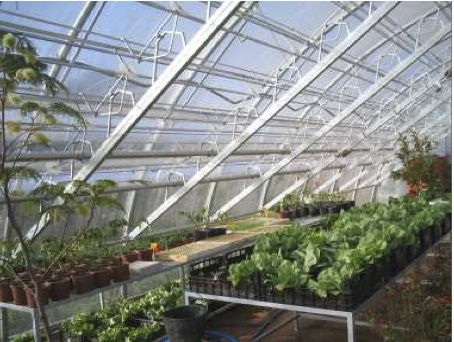 Technology Details - Envelope Greenhouse Technology Details - Envelope Greenhouse
To collect significant amounts of solar energy – whether for thermal or photovoltaic use – requires covering significant areas with collectors. These collectors, along with the precision mechanisms used to track the sun, need to be protected from extreme weather including wind, rain, snow and sandstorms. The materials used, for example stronger frames, add significantly to the capital cost, which is the most significant factor in economic efficiency of a solar power station.
In order to create the best conditions for growth, modern greenhouses, in sunny countries, waste significant amounts of energy for cooling during the day, and for heating at night.
Sunvention’s systems are installed underneath the Greenhouse’s roof, replacing shading systems. The protection of this roof allows for a lightweight, material-saving construction.
Direct radiation is stored as heat for use to heat the greenhouse at night. Any excess heat is converted into electricity. This reduces the thermal load, allowing for a reduction in cooling costs for the greenhouse.
The remaining diffuse light allows for optimal plant growth.
These systems improve the economics for both solar power stations, and greenhouses while allowing for the use of the same area for both activities.
The Envelope Power Greenhouse consists of a number of components which could be licensed separately, along with the knowledge and systems integration expertise to construct complete systems.
 Fluoropolymer Envelope Fluoropolymer Envelope
Fluoropolymers have a lifetime of approximately 30 years, and are transparent to UV radiation which improves both the color and aroma of the food produced, and has a disinfecting effect, reducing the use of pesticides.
In contrast, Polyethylene (PE) films need replacing every 3-5 years, and glass has a higher capital cost and fragility, and needs stronger structures.
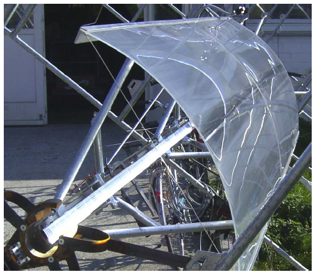 Sunray II – Linear focusing Fresnel lens concentrator Sunray II – Linear focusing Fresnel lens concentrator
Fresnel lenses, inside the greenhouse envelope are used to concentrate direct radiation onto a collector pipe, while allowing diffuse sunlight to reach the plants beneath.
The collector pipe can heat water or oil, and can carry photovoltaics.
Solar Magnet Tracker
Accurately tracking the sun in two axis (up-down, and east-west) is necessary for solar concentrator systems, and can improve the power of non-concentrator systems by roughly 20-35%.
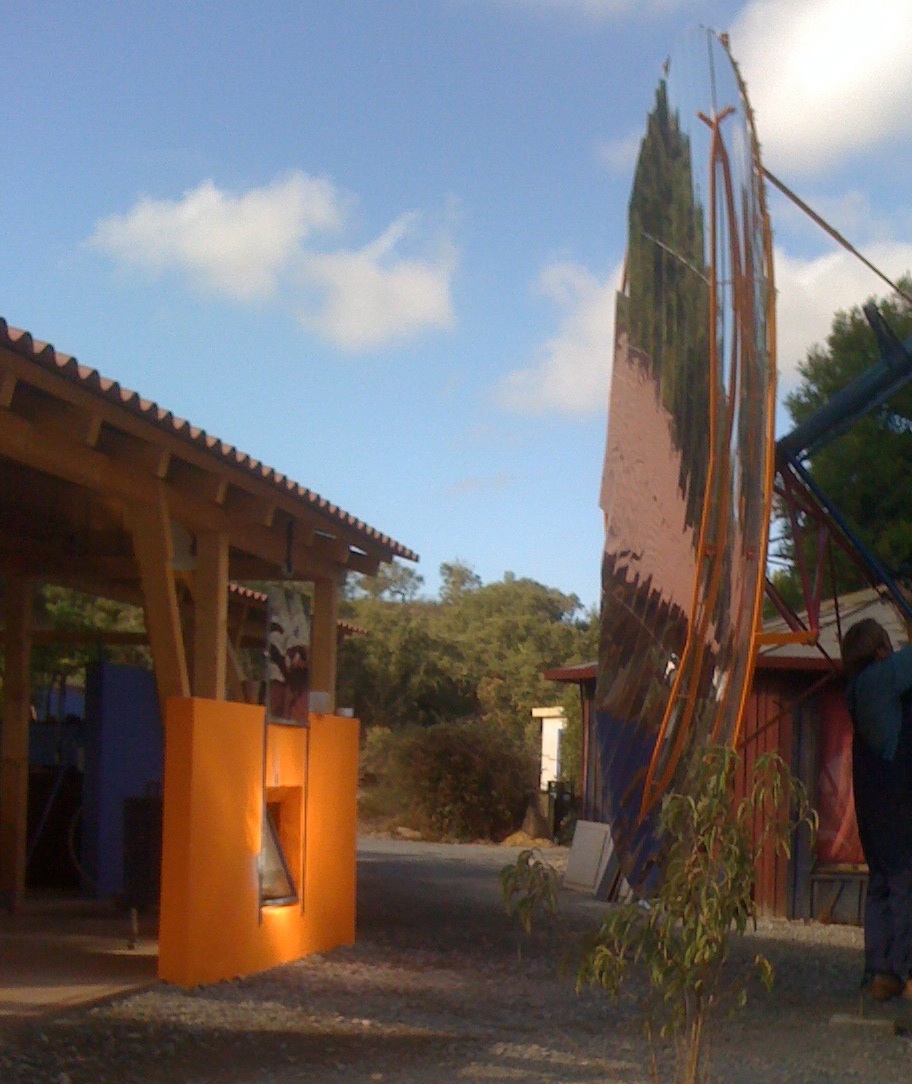
Sunvention has developed a robust and effective controller for tracking. The system is self-learning and easy to fit to diverse tracking systems including uni-axial, bi-axial, and 1½ axis trackers such as the Sunray II.
Hot oil or water systems
In addition to the solar collection, a hot-oil or hot-water system is used to store the heat for use at night to heat the greenhouse, or for use in other systems such as the SunPulse Electric, or the Solar Cooking systems.
Scheffler Mirrors
Large, easily manufactured mirrors focus light onto a secondary mirror that is used to heat the food.
Technology Details - Stirling Engines & Cooking
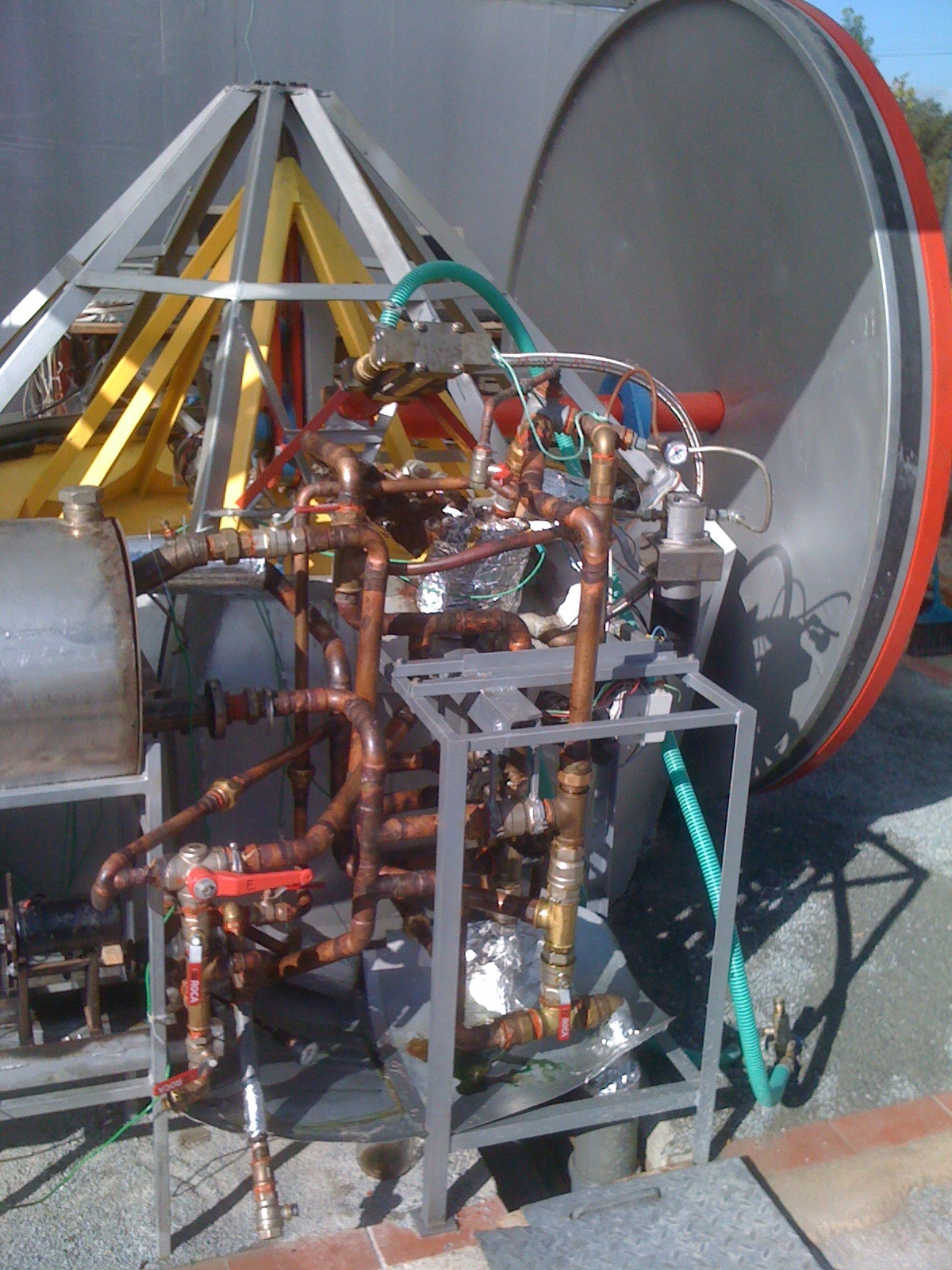 Converting heat into power (electricity or movement) is the basis of most energy sources. Most solutions are expensive and/or use a lot of water. Converting heat into power (electricity or movement) is the basis of most energy sources. Most solutions are expensive and/or use a lot of water.
The Stirling engine is a heat engine in which one side is heated, and the other cooled and a working gas is displaced from side to side in order to gain mechanical energy from its expansion and contraction as it alternately heats and cools.
The principle of the Stirling engine has been known since the nineteenth century. However commercialisation has focused on high-speeds, high-pressures and exotic &/or expensive working gases like helium.
Sunvention has taken on this principle and perfected it through a simplified robust construction that can be built by machine-building companies in developing countries, and maintained locally, and is optimized for using lower temperature, solar generated, heat sources and uses air as the working gas.
A number of specific products have been completed, and an expertise developed in creating solutions to specific problems.
SunPulse Electric
This engine is designed for :
- 24-hour operation, using a stored fluid.
- Operate at moderate temperatures (100-200°C, 212-400°F) allowing for the use of inexpensive, long-lived materials.
- Decentralized application that can be built cheaply in developing countries, be largely maintenance free, and locally maintainable.
- 1.5kW-electrical capacity.
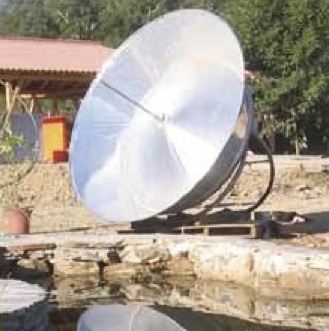 SunPulse Water SunPulse Water
Head
meters (feet) | Volume per day
Litres (Gallons) |
| Field Irrigation |
400,000 l (100,000 g) |
| 10m (33 ft) |
80,000 l (21,000 g) |
| 50m (165 ft) |
17,000 l (4,500 g) |
This engine consists of an integrated solar-collector with a low-temperature, low-speed Stirling engine, directly driving a pump or other need for mechanical power.
The pump, starts working at sunrise, and with 8 hours of sun, the SunPulse Water delivers as shown.TÜV labs recently analyzed the product as producing water at €0.02/m3, less than a third of the cost of Photovoltaic solar pumps.
Buffering systems can be used to enable 24-hour use.
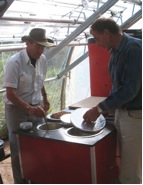 SunFire Solar Cooking Systems SunFire Solar Cooking Systems
Vegetable oil or thermal oil is heated with a solar system such as a SunRay. This oil is stored and pumped from the insulated reservoir into a double-walled stove system. Temperatures of about 220°C (428°F) offer excellent cooking characteristics for frying, cooking or baking.
The system can easily be constructed in developing countries, where it has application within village structures that lack fuel and biomass.
|


 SunFire Solar Cooking Systems
SunFire Solar Cooking Systems